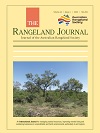
The Rangeland Journal
Volume 44 Number 4 2022
RJ22040In search of sustainable livestock management in the Dry Chaco: effect of different shrub-removal practices on vegetation
Increasing shrub density hinders cattle raising in rangelands of central Argentina. Roller-chopping and hand-cutting are used to remove shrubs and make land accessible for cattle grazing. We found that both practices increase forage quantity, but reduce important attributes of vegetation biodiversity, which is associated with changes in other properties and ecosystem services beyond forage supply. Shrub-removal practices increase forage for livestock, but reduce functional diversity and compromise the return to less disturbed states (woodland), where tree populations are maintained.
RJ22040 Abstract | RJ22040 Full Text | RJ22040PDF (2.1 MB) | RJ22040Supplementary Material (405 KB) Open Access Article
This study contributes to the global understanding of the border sharing rangeland states to enhance cross-border cooperation by establishing joint forums to work on environmental and natural resources, so as to use them sustainably. International boundary making has influenced cross-border pastoralists’ access to environmental resources in the Ethiopia–Kenya borderland. Lack of inter-state institutions that facilitate pastoralists’ mobility to access environmental resources across the borders has affected their livelihoods. However, ethnic social networks and indigenous institutions have facilitated environmental-resource use beyond borders in the Ethiopia–Kenya borderland.
RJ22054Shrubs alter alpha and beta diversity of soil fauna in a semiarid grassland
This research contributes to our understanding of how shrubs influence soil fauna. Shrubs increased alpha diversity, but decreased beta diversity of soil fauna. Shrub effects differ among different taxonomic groups of soil fauna. The results of this work also provide valuable data and analyses that will contribute towards furthering the knowledge and information about arid and semiarid grassland ecosystems.
RJ22047Do regenerative grazing management practices improve vegetation and soil health in grazed rangelands? Preliminary insights from a space-for-time study in the Great Barrier Reef catchments, Australia
 , Brett N. Abbott
, Brett N. Abbott  , Afshin Ghahramani
, Afshin Ghahramani  , Aram Ali
, Aram Ali  , Rod Kerr, Christian H. Roth and Anne Kinsey-Henderson
, Rod Kerr, Christian H. Roth and Anne Kinsey-Henderson
Regenerative grazing, which generally involves some form of rotational grazing with strategic rest, is increasingly seen as a profitable management approach that can accelerate landscape recovery. This study demonstrated that improvements in vegetation, soil and land condition can be obtained by implementing regenerative grazing principles in semiarid rangeland areas of northern Australia; however, it is likely to take a minimum of 3–5 years and up to 15–20 years for statistically significant improvements to be measurable at a site.
RJ22047 Abstract | RJ22047 Full Text | RJ22047PDF (2.7 MB) | RJ22047Supplementary Material (193 KB) Open Access Article
RJ22032Resource partitioning between Caucasian chamois and domestic sheep in mountain pastures of the eastern Caucasus, Dagestan, Russia
Mountain grasslands, where livestock and wildlife potentially compete, are key areas for both biodiversity protection and livestock production. Livestock overgrazing has significantly lessened resource availability for wildlife, and in some cases has led to desertification in arid and semiarid grasslands. A balance between wildlife conservation and existing animal husbandry is possible with careful planning that considers the needs of both. Quantifying livestock carrying capacity is a key issue, with a large number of techniques and studies are available.



